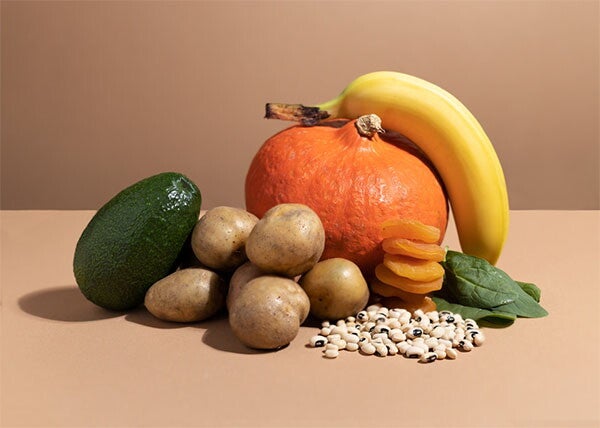
How to Make Sure Your Family Gets Enough Minerals in Food
Quick quiz! Name three minerals in food in five seconds. If you froze after calcium or your brain just shouted "vitamins!", you're forgiven. But it might be a good idea to give minerals some love. Minerals play a huge role in everything from building strong bones to keeping your immune system in check.
Unlike vitamins, which are organic substances, minerals are inorganic elements you'll find in soil or water. Plants absorb them as they grow, and animals get them by eating those plants. That's how minerals end up in the food you eat. But they can also be added to the food with labels like "fortified" or "enriched."
Key Types of Minerals to Know
Here are some essential minerals, their food sources, and the key benefits they offer for children and pregnant women.
Calcium
This mineral builds the foundation for lifelong bone health and supports muscle and nerve function, but its benefits go beyond strong bones. Adults and kids alike need vitamin D to help the body absorb and use calcium effectively.
Calcium benefits have also been tied to heart health. Research in the Annals of Epidemiology involving Japanese moms and their children has linked a pregnant mother's calcium intake to lasting effects on a child’s cardiovascular health.
Calcium-rich food: Milk, tofu, malunggay, mustasa, cooked bok choy, cooked gabi, beans
Iodine
Iodine supports healthy thyroid function, which controls metabolism and growth. The thyroid needs only tiny amounts, but consistently missing iodine can have lasting effects.
Women who become pregnant need to double their iodine consumption, from 100 mg to 250 mg, based on the Philippine Dietary Reference Intakes. Not getting enough of this mineral in food or supplements during pregnancy or early childhood can lead to developmental delays and intellectual disabilities in kids.
Iodine-rich food: Dairy, iodized salt, seaweed or kelp, seafood, iodine-enriched bread
Iron
Iron helps form red blood cells and supports brain development. It also helps prevent anemia, a condition where the body doesn’t have enough healthy red blood cells to carry oxygen, which can manifest as fatigue, pale skin, or even frequent infections.
Iron benefits children and expectant moms in particular. According to the 2023 National Nutrition Survey, 21.7% of pregnant moms and 25.3% of children 6 to 23 months old are anemic. Iron-deficiency anemia has been linked to delayed motor and language skills in early childhood.
Iron-rich food: Organ meats like liver, stewed tomatoes, cooked spinach, cabbage, iron-fortified cereals, cashews, pumpkin seeds
Magnesium
The benefits of magnesium in the body include muscle relaxation, nerve function, energy production, and even mood. This mineral in food helps activate vitamin D, which is essential for calcium absorption.
This study in BMC Pediatrics shows that a combination of vitamin D and magnesium for eight weeks helped improve the behavior and mental well-being of children with ADHD. But researchers say more studies with larger groups of children are still needed to confirm the results.
Magnesium-rich food: Milk, bananas, dark chocolate, brown rice, malunggay, dried raisins (pasas), squash seeds (buto ng kalabasa)
Potassium

Bananas are rich in potassium, but so are avocadoes, squash, and dried fruits such as apricots.
Potassium regulates fluid balance, supports healthy blood pressure, and helps muscles and nerves work properly. It also acts as an electrolyte, helping to balance fluids in the body, which in turn allows the heart and kidneys to function.
Studies have shown that an adequate amount of potassium may help reduce the risk of developing high blood pressure. WHO recommends increasing potassium intake from food to help control blood pressure in children aged 2–15 years.
Potassium-rich food: Bananas, kamote (sweet potato), potatoes with skin, dried prunes and raisins, kidney beans, malunggay, fresh buko juice
Phosphorus
Phosphorus works alongside calcium to build strong bones and teeth. Approximately 85% of the body’s phosphorus is stored in the skeleton, making it essential for maintaining strong, healthy bones and preventing conditions such as rickets. It's also necessary for energy production, helping cells store and use fuel from food.
Based on recommended daily intake, your child's phosphorus needs double, jumping from 500 mg at age 3 to 1,250 mg a day by age 10. Once your child reaches adulthood at 19, the recommended intake drops to 700 mg.
Phosphorus-rich food: Dairy, tomatoes, cauliflower, asparagus, salmon, poultry, pork, legumes, whole wheat bread and cereals
Selenium
Selenium is a powerful antioxidant that helps protect cells from damage. It also plays a role in immune and thyroid function, as well as bone health, all of which are essential for healthy fetal and child development.
Selenium deficiency is a key factor in the development of Kashin–Beck disease (KBD), a joint and bone disorder mainly affecting children.
In pregnancy, this 2025 review published in the Journal of Clinical Medicine shows selenium deficiency increases the risk of complications such as fetal growth restriction and small-for-gestational-age babies. Studies such as this meta-analysis in Biological Trace Element Research suggest a link between lower selenium levels with preeclampsia.
Selenium-rich food: Brazil nuts, sardines canned in oil, tuna, shrimp, chicken breast, cottage cheese, whole wheat bread
Zinc
Zinc benefits include boosting immunity, supporting wound healing, and regulating appetite. Someone with zinc deficiency, regardless of age, may experience a loss of taste and smell, which can start a cycle of poor appetite. Zinc deficiency also causes diarrhea, alopecia, and slow growth in children.
WHO also reports that zinc deficiency in pregnant women can cause premature births or lead to babies with low birth weight.
Zinc-rich food: Oysters, shrimp, meat, oats, eggs, roasted peanuts, Greek yogurt, brown and long-grain rice
How to Get More Mineral-Rich Foods Into Daily Meals

The grocery or the palengke is a great place to introduce your kids to whole foods.
These minerals in food are likely part of your family’s meals already as long as you aim for a balanced plate. You can check out the Food and Nutrition Research Institute’s Pinggang Pinoy guide or this "5-2-1-0" tip to remember what a well-rounded, nutrient-rich meal can look like for kids and adults.
You can also make small, smart changes in how you prepare food and what you stock in your pantry. These strategies are easy to apply and don’t require a lot of adjustments.
1. Choose cooking methods that retain nutrients.
- Steam or lightly sauté vegetables to keep minerals intact. Avoid boiling unless you're keeping the broth.
- Avoid overcooking leafy greens and root vegetables to preserve their nutrients. Instead, keep them slightly crisp.
- Cook with the skin for root crops like potatoes, carrots, and kamote. The outer layers often hold the most vitamins and minerals.
2. Check the "%RNI" on nutrition labels.
The "%RNI" or the recommended nutrient intake indicates the amount of minerals in a food serving in relation to a total daily diet. Aim for a product that provides a serving with 15% of the daily recommended intake based on nutrient reference value (NRV) to count as a helpful source.
3. Go for fortified sources.
Fortified options can help fill in the gaps, especially if your child is a picky eater or you're pregnant and having a hard time keeping food down. Look for iron, calcium, and zinc-fortified cereals, milk alternatives, and even some snack bars.
4. Keep whole foods in rotation.
- Include brown rice, oats, and other whole grains to support your intake of magnesium and iron.
- Beans, lentils, and nuts are cost-effective sources of multiple minerals.
- Eggs are a practical, mineral-rich protein option for both kids and adults.
5. Don't underestimate frozen food.
Frozen fruits and vegetables often retain a significant portion of their mineral content. However, opt for low-sodium or no-salt-added versions whenever possible.
6. Pair vitamins with minerals for better absorption
Some minerals work better when paired with the right vitamins. Here are a few examples:
- Iron + vitamin C helps the body absorb more iron, especially from plant sources.
- Calcium + vitamin D combo allows the body to absorb calcium more efficiently.
- Magnesium + vitamin B6 work together to support nerve function and mood regulation.
These pairings don't have to be in the same bite, but they show how you can approach a balanced meal.
7. Build consistent habits
- A wide variety over time beats trying to get everything into one dish.
- Locally grown vegetables and fruits can be just as powerful as any imported "health food."
- Rotate your ingredients weekly to naturally include more types of minerals without overthinking it.
If you’re concerned about your child’s eating habits or growth, check with your pediatrician. Supplements may be recommended in some instances, particularly during pregnancy or after an illness.
You don't have to overthink minerals in food as long as you always include natural sources like fruits and vegetables in your everyday meals. Eating well is never about a list of dos and don'ts, but rather about maintaining a variety of ingredients and using healthy cooking techniques.
Start small, stay consistent, and keep your pantry working for you! Join the ParentTeam Moms and Dads Facebook group for more nutrition tips.
References
Annie R. McDougall et al., “The Effect of Selenium Supplementation in Pregnant Women on Maternal, Fetal, and Newborn Outcomes: A Systematic Review and Meta-analysis,” American Journal of Obstetrics & Gynecology MFM 5, no. 11 (September 15, 2023): 101160, https://doi.org/10.1016/j.ajogmf.2023.101160
Clarke, Emily. “Following a Low FODMAP and Vegan Diet,” August 12, 2022. Accessed July 14, 2025. https://www.monashfodmap.com/blog/following-low-fodmap-and-vegan-diet/
Powell, Jessie. “Phosphorus - the Nutrition Source.” The Nutrition Source, November 7, 2024. Accessed July 14, 2025. https://nutritionsource.hsph.harvard.edu/phosphorus/
Teofana Otilia Bizerea-Moga et al., “Selenium Status in Term Neonates, According to Birth Weight and Gestational Age, in Relation to Maternal Hypertensive Pathology,” Frontiers in Pediatrics 11 (March 30, 2023), https://doi.org/10.3389/fped.2023.1157689
World Health Organization: WHO and World Health Organization: WHO. “Anaemia,” February 10, 2025. https://www.who.int/news-room/fact-sheets/detail/anaemia
Yang, Xuesong, Cheng Liu, Yanbo Liu, Zhigang He, Juan Li, Yijing Li, Yanqiong Wu, Anne Manyande, Maohui Feng, and Hongbing Xiang. “The Global Burden, Trends, and Inequalities of Individuals With Developmental and Intellectual Disabilities Attributable to Iodine Deficiency From 1990 to 2019 and Its Prediction up to 2030.” Frontiers in Nutrition 11 (June 17, 2024). https://doi.org/10.3389/fnut.2024.1366525









